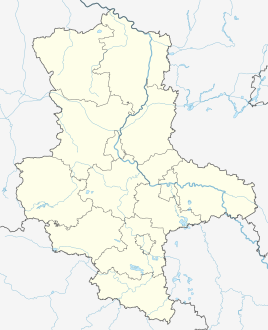Glow
|
Glow
City of Staßfurt
|
||
|---|---|---|
| Coordinates: 51 ° 54 ′ 35 " N , 11 ° 40 ′ 30" E | ||
| Height : | 74 m above sea level NN | |
| Residents : | 642 (Dec. 31, 2013) | |
| Incorporation : | May 18, 2006 | |
| Incorporated into: | Förderstedt | |
| Postal code : | 39443 | |
| Area code : | 039266 | |
|
Location of Glöthe in Saxony-Anhalt |
||
Glöthe is a district of the town of Staßfurt in the Salzlandkreis in Saxony-Anhalt , Germany .
geography
The district of Glöthe lies in the south of the Magdeburg Börde between Bode and Saale . The small lakes around Glöthe are former opencast mining holes (today partly a landscape protection area). The village is located at an altitude of 74 m above sea level. NHN on flat undulating and productive soil.
history
The place is first mentioned in 1226 in connection with a Ludolph von Glothen. Historians suspect that the place name Glöthen developed from the Slavic word Klodno or Klode for block of wood . At the beginning of the 14th century Glöthe was owned by the Prince of Anhalt-Bernburg Bernhard II , who passed the place to Archbishop Burchard III in 1317 . sold by Magdeburg . In 1370 this had to pledge Glöthe to the magistrate of Magdeburg , to which the property rights were finally transferred. In the 18th century, the von Alvensleben family acquired Glöthe as a manor . At that time there were 46 houses in the village and five farm workers, six half-spouses and ten farmers were employed. In 1680 the place came under Brandenburg-Prussian rule. After the defeat of Prussia by Napoleon , it belonged to the French-ruled Kingdom of Westphalia and was administered by the Canton of Calbe in the Magdeburg district. After the expulsion of the French, Glöthe came back to Prussia and became part of the district of Calbe a./S. assigned. Until the 19th century Glöthe was purely agricultural. With the opening of the Schönebeck – Güsten railway line in 1857, the mining of lignite and limestone, and the construction of a cement factory, many industrial workers moved into the village, the population of which increased from 496 in 1840 to 1302 in 1910. At the beginning of the Second World War , the number of inhabitants had already decreased to 1,242 in 1939. In April 1945, Glöthe was captured by US troops and three months later it was handed over to the Red Army . As part of the land reform carried out in the Soviet occupation zone (SBZ) from 1945 to 1946 , the manor of Alvensleben was expropriated and resettled in individual farms. In the course of the nationalization of the industrial companies, the cement works became a state-owned company (VEB) Kalk- und Zementwerk Glöthe. After the GDR was founded in 1949 in the area of the Soviet occupation zone , it carried out a first regional reform, with which u. a. the district of Calbe with Glöthe on July 1, 1950 in the newly formed district of Schönebeck . At the same time, the place Üllnitz was incorporated into Glöthe. In an even more far-reaching reform, on July 25, 1952, the states in the GDR were abolished in favor of districts , whereby Glöthe was assigned to the Magdeburg district . In the same year the Agricultural Production Cooperative (LPG) "Unity and Peace" was founded, which all farms had to join by 1960. In 1955 a central aqueduct was built in Glöthe. The population was given in 1964 as 1733. After German reunification in 1990 , the LPG was transformed into an agricultural cooperative under German law. The Ulm cement company Schwenk Zement built a new building materials plant and BASF built a plant for concrete admixtures. With effect from May 18, 2006, Üllnitz was incorporated together with Glöthe and Brumby into the community of Förderstedt and on January 1, 2009 it became a district of Staßfurt. On May 18, 2006, the community of Glöthe with about 745 inhabitants was incorporated into Förderstedt . On January 1st, 2009 Förderstedt was incorporated with Glöthe in the city of Staßfurt. This made Glöthe an independent district of Staßfurt.
coat of arms
Blazon : "Diagonally to the left, divided by silver and blue, floating above a red brick wall with three chimneys, below four golden ears of corn, the stalks covered with a golden sugar beet."
Attractions
The Protestant St. George Church is in the center of the village south of Friedensstrasse. It was rebuilt several times to be Gothic in its core . In its present form it consists of the square west tower, nave and a southern, pointed gable extension. To the east the nave ends with a polygonal closure. There are two windows from the 19th century with images of the apostles Peter and Paul . The interior of the flat-roofed nave includes the altar plate with four Romanesque consecration crosses and a reliquary as well as the 17th century pulpit . In the basement of the tower is the crypt of the manor owner and church patron Johann Engel Wahnschaffe.
Transport links
Glöthe is on the federal highway 14 ( Magdeburg - Halle ), there are further road connections to all surrounding cities. The next train station is in the neighboring village of Förderstedt (route Magdeburg - Schönebeck (Elbe) - Güsten ).
literature
- Georg Dehio: Handbook of German Art Monuments - Saxony-Anhalt I. Deutscher Kunstverlag Munich / Berlin 2002, p. 122, ISBN 3-422-03069-7 .
- Ed. Kirchenkreis Egeln: Blessings on wide land - The churches of the Protestant church district Egeln. Edition Akanthus, Spröda 2016, p. 64.
- Historical-geographical-statistical-topographical manual from the administrative district of Magdeburg 1842 (pdf file: [1] )


